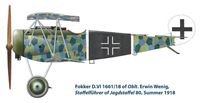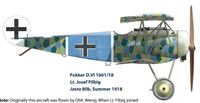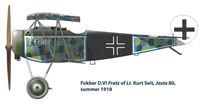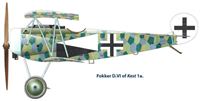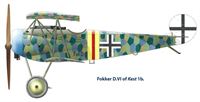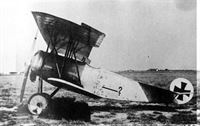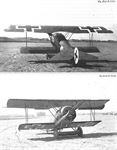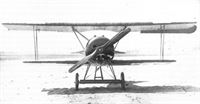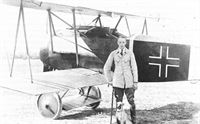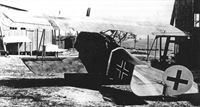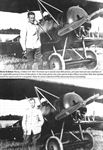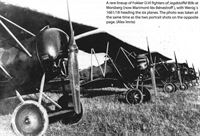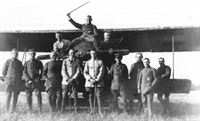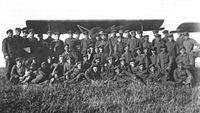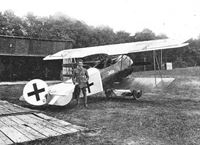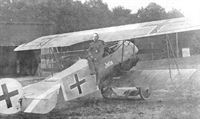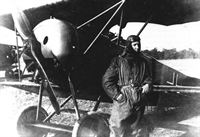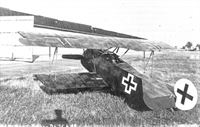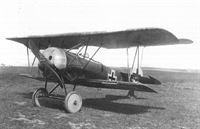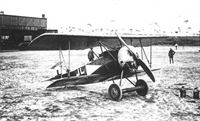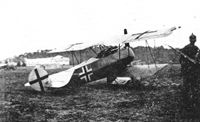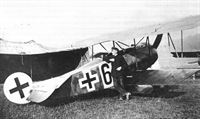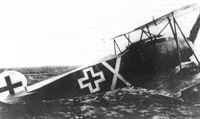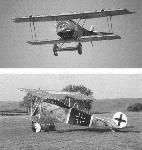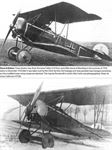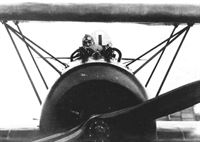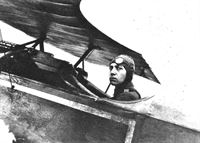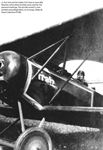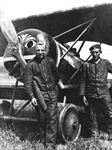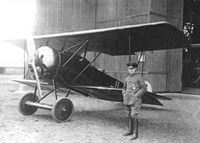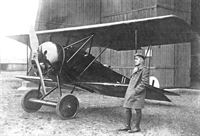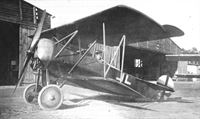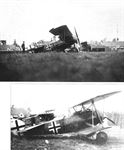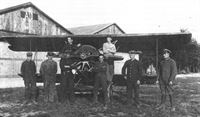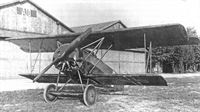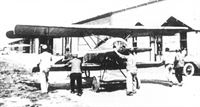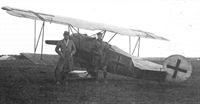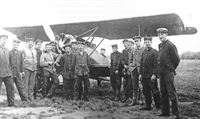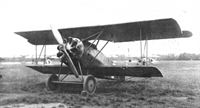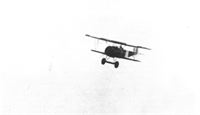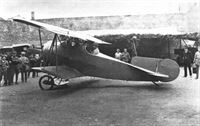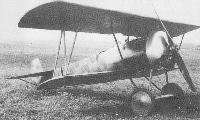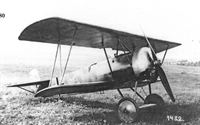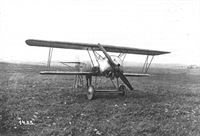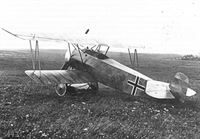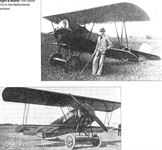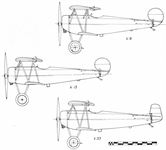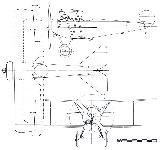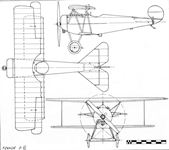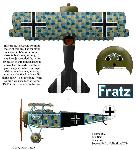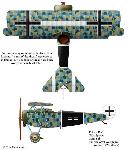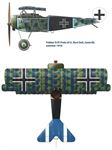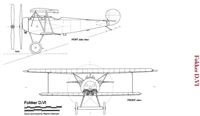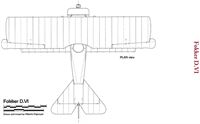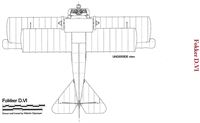В.Кондратьев Самолеты первой мировой войны
Вскоре после запуска в серию истребителя-триплана Dr.I фирма "Фоккер" вернулась к "традиционной" бипланной схеме. В декабре 1917 г. Рейнольд Платц, разработал самолет под заводским обозначением V.13. Его фюзеляж был практически идентичен фюзеляжу "драйдеккера", но, вместо трех несущих плоскостей, самолет имел два крыла увеличенного размера и площади, соединенных N-образными стойками из стальных труб. От своего предшественника машина унаследовала толстый профиль деревянных крыльев с полотняной обшивкой и безрасчалочную схему бипланной коробки.
В январе-феврале 1918 г. V.13 принимал участие в конкурсе перспективных моделей истребителей в Адлерсхофе. Самолет показал хорошие скоростные данные, но по другим параметрам - уступил более энерговооруженному и аэродинамичному истребителю той же фирмы "Фоккер" D.VII, который приняли на вооружение по результатам конкурса.
Тем не менее, с апреля по август 1918-го была построена небольшая серия в 59 машин, получивших обозначение "Фоккер" D.VI. Во многих из них них использовался задел двигателей, деталей и узлов, собранный для только что снятого с производства Dr. I. Большинство самолетов оснащалась немецкими ротативными двигателями "Оберурсель" Ur.II, остальные - шведскими моторами "Тулин". Вооружение - два синхропулемета LMG 08/15. Первый серийный экземпляр построен 26 апреля 1918 года.
Лишь незначительное число D.VI в течение лета поступило на вооружение немецких истребительных эскадрилий западного фронта, большинство же отправили в учебные подразделения.
Семь самолетов в августе 1918 г. приобрела Австро-Венгрия. Эти машины были куплены без вооружения и оснащены австрийскими авиапулеметами "Шварцлозе".
ДВИГАТЕЛЬ: "Рон" шведской постройки (110 л.с.) или аналогичный "Гебель Гоэ" германского производства.
ВООРУЖЕНИЕ: идентично "Фоккеру" Dr.I.
ЛЕТНО-ТЕХНИЧЕСКИЕ ХАРАКТЕРИСТИКИ
Размах, м 7,66
Длина, м 6,19
Площадь крыла, кв.м 17,7
Сухой вес, кг 392
Взлетный вес, кг 582
Скорость максимальная, км/ч 190
Время подъема на высоту
2000 м, мин.сек 5,30
Потолок, м 5940
Показать полностью
A.Weyl Fokker: The Creative Years (Putnam)
IN ERSTER LINIE ALLE APPARATE D.VII ...
Fokker’s personal design inspirations cooled off after the spectacular failure of the V.8 monstrosity, and Platz was able to get on with sensible designs. He wanted to develop a monoplane with a cantilever wing. Fokker was not keen on the idea: monoplanes were out of fashion. A biplane on the lines of the V.4 would probably have a better chance of winning production orders, provided it was as simple as the triplane and its wings were not obvious cantilevers.
A competition for the selection of new fighter types was shortly to be held at Adlershof. Fokker insisted on entering as many types as possible: in his opinion, the broad approach offered the best prospects of success. The IdFlieg had indicated their intention of ordering rotary-powered fighters as well as aircraft with stationary engines. The Army had invited attention to the promising new 160-h.p. Siemens engine, and stated that they wished to consider prototypes with this engine.
With all these considerations before him, Fokker again decided on the parallel development of two prototypes, one a light, rotary-powered aircraft, the other a larger machine with a 160-h.p. Mercedes.
It was decided that the new type should be a sesquiplane. Platz’s first attempt was the V.9, a small biplane that originally had an 80-h.p. Oberursel engine. After the first flight tests this was replaced by a 110-h.p. Le Rhone. The V.9’s direct descent from the V.4 was apparent: its fuselage, tail unit, undercarriage and engine mounting were all virtually identical with those of the triplane. The V.9’s lower wing had the same compounded spar arrangement and was located in a recess in the underside of the fuselage. The upper wing was of greater span and chord, and its two box spars were at a conventional distance with drag bracing between them. The cabane structure consisted of two tripods of steel tubes and was somewhat similar to that of the V.1. Both wing spars were bolted to the four apices of the tripods.
Both wings were integral structures covered with fabric, and were dimensioned as cantilevers. Merely to reduce their flexing under load, and to satisfy Fokker, a V-strut was fitted between them. The lower end of the strut was made broad enough to provide an attachment that was connected to both the basic spars of the lower wing. Without knowing it, Platz had thereby avoided the structural weakness of the Albatros fighters - the possibility of oscillatory torsion of increasing amplitude in the lower wing under certain conditions of flight. The V.9 cabane structure needed no diagonal bracing, consequently the aircraft was truly verspannungslos.
The aerofoil section of the V.4 was employed in both wings. There was no stagger, and the wings were made without dihedral. Ailerons were fitted to the upper wing only; to Platz’s displeasure, they had horn balances.
The pilot’s forward field of view was unobstructed. The upper wing was somewhat above his eye-level, and a large cut-out was made in the trailing edge in order to improve his outlook. Despite the greater wing chord, the field of vision was better than that of the Fok. Dr.I.
The V.9 was rather a small aeroplane, with a span of about 7-5 m. (24-6 ft.) and a length of less than 5-9 m. (19-5 ft.). It was also very light, and its wing loading was about the same as that of the Fok. Dr.I. In its final form the V.9 was demonstrated at Adlershof, but it was never subjected to an official structural test, nor was it fitted with guns. It remained purely experimental.
<...>
Yet another experimental biplane fighter was built and tested at Schwerin before the end of 1917. This was the rotary-powered Fokker V.13, which appeared in two versions, each with a different engine.
The V.13 design was intended to have a better climb performance at altitude and a higher ceiling than the V.9. To this end the wing area was increased. The lower wing no longer had the compound spar box of the V.4: it was of greater chord and had separate spars like that of the V.11, consequently N-type interplane struts were employed. The upper wing was also larger than that of the V.9. The V. 13 cabane was generally similar to that of the V.11, differing only in having the front strut of the tripod attached to the forward end of the lower longeron. The tail group resembled that of the V.9; there was no fin.
Power for the first version of the design, V.13/I, was provided by a 110-h.p. Oberursel (Le Rhone) UR.II.
The V.13/II had the 160-h.p. Siemens-Halske Sh.3 eleven-cylinder birotary engine, which necessitated a taller undercarriage; otherwise it was a replica of V.13/I. It had an excellent rate of climb and a high service ceiling. Fokker, of course, considered that the ingenious Sh.3 engine was an imposition laid upon him by the IdFlieg, and hoped to replace it by the new 145/160-h.p. Oberursel UR.III as soon as the first pre-production engines became available. As far as is known, the V.13/II remained experimental.
The first Adlershof fighter trials
The first of the three comparative trials for the selection of new singleseat fighters began late in January 1918. The idea was admirable in theory, but it must be admitted that the results, on the whole, were no more than moderately satisfactory. This was because some of the notable fighting pilots who flew the competing aircraft were in the pay of individual firms, and consequently gave biased opinions in favour of the products of those firms. Three years of war and the insidious growth of bribery in Germany had not passed unnoticed by the young fighting pilots, and it is perhaps not surprising that their conceptions of honour had become somewhat tarnished. Ultimately it became an open secret that certain officers in command of fighting formations received favours from certain firms for “plugging” their products and denigrating those of their competitors.
Among the laudable exceptions was Manfred von Richthofen, who set an example as a conscientious Prussian officer of absolute integrity. At the other end of the scale was Hermann Goering, later a notorious member of the Hitler gang. Officers serving with or under him knew that he could be bought.
The aircraft manufacturers made the most strenuous efforts to capture the bulk orders and went to almost any length to win the approval of the pilots for their products. All firms, Fokker included, had entertainment managers whose job it was to arrange lavish dinners and parties for the pilots. These young men were consequently seldom in any physical condition to assess any aircraft dispassionately. Valuable presents such as gold cigarette cases were distributed; the more “progressive” pilots were paid in cash.
When the competitive flying began, the Adlershof aerodrome - normally strictly out of bounds to all civilians - swarmed with commercial representatives of the aircraft industry. After this impromptu trade fair had gone on for a week or two, greatly impeding the flight trials, the officers in charge of the competition decided to clear the aerodrome of those civilians who had no immediate connexion with the trials. The party-worn pilots could then get on with the real business of sampling the prototypes that had passed the structural examinations or were otherwise assessed as safe enough for familiarization flights.
The ban on civilians applied to Fokker. Not to be outdone, he flew over the forbidden area in one of his old experimental aircraft to have a look at what was going on. He could do this easily enough, for he had retained one of his old sheds on the Johannisthal side. Why this had not been requisitioned in August 1914 is a mystery. In it he had strategically planted his aeroplane and his personal mechanic Schmidt.
One cannot but admire the thorough and extensive preparations that Fokker had made for these trials. He entered no fewer than eight aircraft: four biplanes, three triplanes and a mid-wing monoplane. While the trials were in progress, a further monoplane followed. This was the V.20 which, as described in Chapter X, was designed and constructed by Platz within the space of a week while Fokker was at Adlershof.
The best mechanics of the Fokker works were at Adlershof too. Indeed, the Fokker team was the best organized of ah the competitors.
Although Albatros, L.F.G.-Roland, Pfalz, Rumpler, Siemens, Schutte-Lanz and other companies had made efforts to comply with the suggestions of the IdFlieg, they had not prepared so comprehensively nor so wisely as Fokker. It soon became clear that he had presented prototypes that were good in all respects that mattered, and had not been developed in one specific direction at the expense of all other considerations. Most of the other types excelled in one aspect of performance but failed to be satisfactory in a general way. It was one of Fokker’s great gifts as a pilot to sense how the qualities of an aeroplane should be blended to produce a really practical and useful aircraft. He never sought to have emphasis on any specific quality - say, speed, or climb, or ease of handling - but preferred to achieve a balance that would meet with the approval of operational units.
Of Fokker’s four biplane entries, two (the V.11 and V.18) had the latest high-compression version of the 160-h.p. Mercedes, the type D.IIIau. The IdFlieg wanted to compare prototypes with this engine because it had been ordered in quantity from Daimler.
As noted earlier in this chapter, the V.13/II had the 160-h.p. Sh.3 engine for the same reason. However, the Sh.3 had not then passed its type test and was not in quantity production, only small batches being built.
Fokker also succeeded in his desire to oppose the Siemens-Halske engine: he managed to get one of the first of the new Oberursel UR.III rotaries and had it installed in the V.13/I for demonstration against the V.13/II with its Sh.3. He seemed oblivious to the fact that the new Oberursel was inferior in altitude performance and propulsive efficiency. As it was a modification of the well-tried Le Rhone, he was convinced it was better suited to operational needs.
The IdFlieg had indicated that two fighter types would be chosen for quantity production, one with the Mercedes engine and another with a rotary engine not yet specified. Fokker hoped it would be the Oberursel: the Siemens people hoped equally that it would be their own engine, which was then being evaluated at the front.
Soon after the trials began, Fokker asked Manfred von Richthofen to try the V.11 He flew it on January 23, 1918. When he landed he told Fokker that it had a good performance and was manoeuvrable, but its flying qualities were unsatisfactory. This was so: it was tricky to handle and directionally unstable; when dived, it had a strong tendency to swing. This was unacceptable in a combat aircraft. Its stalling characteristics were unpleasant and might lead to accidents. If these vices could be remedied, the V.11 stood a good chance of success. Von Richthofen was delighted to note that Fokker had incorporated the control grip and gun triggers that he favoured, in place of the usual press-buttons.
Fokker heeded von Richthofen’s criticism: he knew it was justified. He had had little opportunity to fly the V.11 himself, but his brief acquaintance with it had sufficed to tell him that its flying characteristics were unpleasant, and that it needed careful handling.
And so it was that the extensive modifications that have already been described came to be hastily undertaken in the Fokker shed at Johannisthal. Expert welders and other workmen, with tools and materials, were summoned from Schwerin to work all hours over the week-end under Fokker’s direction. Fokker took great care to conceal the extent of these modifications from the technical officers and other competitors. This was a wise precaution, for the structural reliability of the aircraft might have been questioned after such extensive rebuilding. Fokker let it be known that the V.11 had had a slight landing mishap and needed some repairs. It was normal practice for minor repairs or engine overhauls to be undertaken during the trials, and any suspicion that might have attached to the V.11’s temporary disappearance was further reduced because the job was done at a week-end, when the aerodrome was deserted.
With Fokker’s usual luck, everything went smoothly. A trial flight showed him that the V.11’s handling characteristics were greatly improved, although at the expense of some manoeuvrability. But it was now really safe to fly, and could be dived without any swing developing. At the first opportunity, Fokker suggested to von Richthofen that he should try the aircraft again: the control gearing had been adjusted, Fokker explained, and the Herr Rittmeister would now find it more pleasant to fly. Von Richthofen was surprised that these “small adjustments” had made the V.11 so delightful to handle; it was now vice-free. He urged other pilots, notably Loerzer, to try it. It seemed to be a really promising aeroplane.
The Trials
The Adlershof trials began on January 21, 1918, a mild day with only a thin layer of cloud at about 13,000 ft. All works pilots were busily engaged on the climbing tests under the control of the Adlershof technicians. These officials weighed every aeroplane before and after flight, noted the type of airscrew used on each (to ensure that the same one would be used in the speed tests), and installed two sealed and calibrated barographs. Refuelling was supervised to guard against the use of any special mixtures. All of these precautions were necessary to avoid cheating by enterprising manufacturers.
The best climbing performance was put up by a Siemens-Schuckert D.III fitted with a special Siemens Sh.3 engine: this gave about 220 b.h.p. on the ground and drove its airscrew at 2,000 r.p.m. instead of the usual 1,800 r.p.m. maximum. This S.S.W. D.III reached an altitude of 6-0 km. (20,000 ft.) in twenty-two minutes. Service pilots, however, found this aircraft rather tricky to land and less manoeuvrable than the Fokker biplanes.
Fokker demonstrated the not-yet-modified V.11 and, later, the V.13/I with its new 145-h.p. UR.III engine at low altitudes. His superb handling of these aircraft made a great impression. Another UR.III engine was tested in a Fokker triplane.
The second day was again mild. The V.9 fitted with a 110-h.p. UR.II, had to make a forced landing outside the aerodrome owing to engine trouble after a climbing trial, and was damaged. The new Junkers D.I low-wing monoplane was flown against an Albatros D.Va, an obsolescent type. The Albatros was flown by Hauptmann Schwarzenberger, the head of the fighter experimental section of the Flz. and its chief test pilot. The Junkers was flown by Fokker, as a director of the Junkers-Fokker Works. To everyone’s amazement the Junkers proved the slower of the two. Fokker explained afterwards that the Junkers had an airscrew whose pitch was too fine; his engine threatened to overspeed and consequently he had to throttle down. There was undoubtedly something wrong with the airscrew, for it disintegrated in flight. Fokker managed to land the monoplane undamaged.
Later in the day he tried the V.13/I with the UR.III, but the engine was still running unsatisfactorily.
On the third day the fighter pilots were allowed to try those prototypes that had been structurally cleared. Oberleutnant Bruno Loerzer tried one of the new Siemens-Schuckert D.IIIs but, despite his skill and experience, crashed it when landing. Oberleutnant Ritter von Tutschek turned turtle in an Albatros D.Va fitted with the high-compression Mercedes. As already mentioned, Manfred von Richthofen tried the unmodified V.11; he found it faster than the Albatros D.Va, against which it was flown for comparison of speeds. The representatives of other firms grew uneasy when von Richthofen flew the Fokker V.11 as his first aircraft: a rumour that he “was sold on Fokker” went around. This was quite unjustified. Manfred von Richthofen, then as always, was completely impartial and unbiased.
Fokker’s pilot Schuetzenmeister climbed to 4-0 km. (13,200 ft.) in the V. 13/I, but the engine failed to give the expected power. Fokker demonstrated the V.17 mid-wing monoplane for the first time. When it was matched against the V.11, the Pfalz D.IIIa and the Albatros D.Va, the monoplane was the slowest of all. It was during the afternoon of this day that Fokker made the telephone call to Platz that resulted in the V.20, which Fokker flew at Adlershof eight days later.
On January 25, misfortune befell the Fokker team. While thick fog covered the aerodrome, a mechanic of the Oberursel works taxied the V.13/I into the V.18. This aircraft and an Albatros standing nearby were extensively damaged.
When the fog lifted during the afternoon, the Fokker works pilot Grosse climbed in the V.11 to 5-0 km. (16,500 ft.) in 30-7 minutes, despite unfavourable weather. In a later climb he put up the impressive time of 25-2 minutes to the same altitude.
In their first discussions with the Adlershof technicians, the fighter pilots expressed disappointment with all the aircraft they had sampled. Climbing times of 25 to 30 minutes to reach 6-0 km. (20,000 ft.) were regarded as acceptable, but all the new types were slow. This opinion reduced the chances of those firms who had aimed primarily at producing fast-climbing fighters; it had a particularly adverse effect on the types with the Siemens Sh.3 engine. The conclusion was that fighters with water- cooled engines were preferable for operational purposes; they were faster but did not have such good climbing performances.
Another of the Siemens-Schuckert D.III biplanes made a crash landing and turned over. An identical aircraft, however, made the climb to 6-0 km. (20,000 ft.) in 20 minutes. The Fokker V.13/I, flown by Schuetzenmeister, took 22 minutes to climb to 5-0 km. (16,500 ft.).
Few flights were made during the seventh day because most of the pilots were too fatigued, from one cause or another. Fokker, as a lifelong abstainer, had no hangover, and flew the V.17, climbing to 5-0 km. (16,500 ft.) in 24 minutes. This was a good performance on the low power of the V.17’s UR.II engine. The V.18 had been repaired and made a trial climb, piloted by Heide; its time was disappointing, however.
The next day was distinguished by a dense fog and the removal of all unnecessary commercial representatives from the aerodrome.
In the quieter atmosphere that followed, the trials continued with more serious flight testing and sober discussion of the results. Climbing trials, speed comparisons and mock combats were held, interspersed with familiarization flights by the fighter pilots. There were sundry crashes, all in landing accidents. The second Schutte-Lanz D.III, a promising design by W. Bleistein, was written off after a particularly ill-judged landing.
During the first few days of February, the Fokker triplane variants with the 200-h.p. Goebel Goe.III and 145-h.p. Oberursel UR.III engines made spectacular climbs, piloted by Matthias and Grosse. They failed to give the Fok. Dr.I a new lease of life, however, for the type was regarded as much too slow. The climbs served only to demonstrate the capabilities of the new rotary engines.
The Choice
The fighter pilots were now asked to indicate which two of the various prototypes they thought best, one with the Mercedes engine, the other with a rotary.
Two different types had to be selected because the German Army Flying Corps did not believe in complete standardization of its aircraft or engines. There was the pre-war example of Austria to point the dangers of standardization in a field that was developing rapidly; and there was the further operational proof of the British Royal Aircraft Factory types. The German engineering experts welcomed the official policy which, by spreading responsibility over a number of firms, provided a form of insurance against set-backs.
<...>
There was much less unanimity about the choice of the rotary-powered fighter type. The pilots said that all the prototypes with rotaries were more difficult to handle than the V.11, and their engines gave the impression of being less reliable. This was perfectly true.
Pfalz, the L.F.G. and Siemens had made efforts to produce fighters with a fast rate of climb and high ceiling. These were useful characteristics where interception was the prime consideration, but the engines were all still in the experimental stage. Until these new engines had been developed to an acceptable standard, the well-tried Le Rhone would have to be retained for operational purposes. The Flz experts concurred.
Some pilots expressed preferences that puzzled the Service test-pilots: recommendations were made in respect of aircraft that were obviously inferior and had been included in the trials merely because they were interesting and not unsafe.
There was agreement over the Siemens entries: although they had an excellent rate of climb and were reasonably fast at altitude they were much too tricky and obviously required further development. The Siemens-Halske engine was not yet sufficiently reliable.
The Pfalz D.VII, which unfortunately had the same engine, had given a better account of itself and was considerably faster. It was well built and fairly easy to handle. The Pfalz D.VI won a measure of support by virtue of its 110-h.p. Le Rhone engine, but its performance was inadequate. A majority regarded the L.F.G.-Roland effort as a wash-out.
Finally, Manfred von Richthofen’s advice prevailed. He recommended the Fokker V.13 as the best all-round type. It was easy to fly, very manoeuvrable, and otherwise similar to the V.11. As the V.11 had already been recommended, the similarity of the two types would be an advantage when pilots had to switch from one to another.
The V.13/II with its Siemens engine had a measure of support from the IdFlieg officials. Little had been seen of it during the trials, partly because it had been damaged, partly because the owner of the Oberursel firm had little interest in promoting the Siemens engine. In a climbing test, Mathias had flown the V.13/II to an altitude of 4-5 km. (15,000 ft.) in 19-5 minutes. Although this fell appreciably short of Leutnant Mueller’s record climb of 5-0 km. (16,500 ft.) in 13 minutes on the Service version of the Siemens-Schuckert D.III with the same engine, it was considerably better than the performance of the Fokker V.13/I with the 145-h.p. Oberursel UR.III.
But the fighter pilots wanted neither the Siemens-Halske Sh.3 nor the Oberursel UR.III: they preferred the 110-h.p. Bente Le Rhone which had proved so satisfactory in the Fok. Dr.I. Their final choice of a rotary-powered aircraft was the Fokker V.13, but with the 110-h.p. Le Rhone.
This recommendation was accepted by the authorities, but the type was ordered in small numbers only, pending the availability of a more powerful rotary for operational service.
Hauptmann von Falkenhayn of the Kogenluft’s staff told Fokker of the decisions and congratulated him on his double success. Fokker was asked how soon he could arrange for type tests to be made, and how quickly he could supply production aircraft. He retorted that he could promise nothing, for his factory was cluttered up with those A.E.G. C.IV trainers that the IdFlieg had inflicted on him.
At that moment Fokker did not know that this very problem had been discussed when the question of giving him direct orders was considered, and the IdFlieg had agreed to cancel the A.E.G. contract in favour of the new fighter types. The alternative would have been to order only prototypes from Fokker and place the production contracts with better-equipped firms. This idea was rejected, however; the A.E.G. trainers were not too badly needed, and there was no wish to stifle Fokker’s eagerness to get production going.
Fokker was promised, on the spot, a provisional order for 400 V.11-type aircraft, subsequently designated Fok. D.VII, at £1,250 per airframe (1914 value), a very generous price. He was told to initiate production with all possible speed: to expedite matters, the existing prototypes should be modified to production standard for test purposes. This was the biggest order Fokker had received up to this time.
His amazement grew when he learned that his main rivals, the Albatros concern, were to build the V.11 under licence; so were the Ostdeutsche Albatros Werke and the A.E.G. This was a triumph for the little Dutchman who, at a time when his paternal subsidy looked like being cut off, had thought of offering his services as a flying instructor to the Albatros Werke before the war. For every licence-built V.11 he was to get a standard fee of 5% of the airframe price.
Viewed against the other prototypes submitted for the Adlershof trials, and bearing in mind the supply position in blockaded Germany, no better choice than the V.11 could have been made. Its selection was amply vindicated by its subsequent operational success. The choice of the V.13 was also sensible in the circumstances.
Fokker had succeeded by rights and had arrived at the top of the German aircraft industry. He had beaten his competitors fair and square in the most exacting competition ever held, for the largest German contracts ever awarded. All he now had to do was to keep Reinhold Platz at work and not let him feel too important!
The Fokker D. VI
The V.11 still needed detail improvements and minor modifications. Fokker hoped to improve its climb, reduce the weight a little, and improve the flying qualities even further. A second specimen of the V.11 was built for Adlershof.
The V.13 was therefore the first of the two successful designs to undergo an official type test. The aircraft that was tested was re-converted to have the 110-h.p. UR.II engine. Early in February 1918, a few days before the fighter trials ended, a V.13 airframe was tested to destruction at Adlershof. A report dated February 18, 1918, cleared the airframe without restriction. Even the (formerly rare) Case C loading had been sustained without any structural failure. Platz had accomplished the near miracle of complying with all BLV requirements without even knowing of their existence.
The type test of the 110-h.p. version, the Fok. D.VI, took place on March 15, 1918. In the climbing test an altitude of 5-0 km. (16,500 ft.) was reached in 29-9 minutes: the service ceiling was 5-6 km. (18,500 ft.). This was not good enough for service on the Western Front, and only limited production was recommended until a development with the 200- h.p. Goebel Goe.III engine could be evaluated. Single aircraft with the first pre-production Geo.Ill engines were ordered. Take-off and landing of the UR.II-powered Fok. D.VI were surprisingly good, the runs being 35 m. (37-5 yd.) and 40 m. (44 yd.) respectively. The empty weight was now 427 kg. (940 lb.), whereas originally the unarmed V.13 had weighed 393 kg. (865 lb.) empty. The standard armament consisted of two LMG 08/15 machine-guns synchronized by the Zentral-Steuerung.
The V.13/II with 160-h.p. Siemens Sh.3 was type-tested on May 15, 1918. It was not accepted for production, however, because operational trials of the Siemens-Schuckert D.I1I had shown the engine to be troublesome. Moreover, the Goe.III-powered version of the Fok. D.VI was then in production and was to be operationally tested by home-defence fighter units. The first Goebel-powered Fok. D.VI (D.1643/18, Factory No. 2625, engine No. 66) underwent its acceptance flight-test at Schwerin-Goerries, flown by Grosse, on May 21, 1918.
Some three weeks earlier, a production Fok. D.VI (D. 1631/18, Factory No. 2613) had been delivered for engine trials with the 145-h.p. DR.III (engine No. 2884). Few examples of this variant were supplied, however.
The Fok. D.VI saw little operational use on any major front. Its performance in speed and climb was not good enough; and it was slow to accelerate in a dive. On July 1, 1918, only twenty-one Fok. D.VIs were in operational use; on September 1 the total was twenty-seven. After this date all aircraft of this type were relegated to home-defence and training units.
Seven Fok. D.VIs with UR.II engines were sold to the Austrian Army on August 19, 1918. They were shipped without acceptance flight tests. These aircraft had the Factory Nos. 2614-2617, 2623, 2624 and 2628; they were part of a block originally ordered by the IdFlieg, consequently their allotted Order Nos. (D.1632-1635/18, D.1641/18, D.1642/18 and D.1644/18) were cancelled. The Austrian D.VIs differed from standard in their armament: they had a fixed, synchronized Schwarzlose machinegun on the fuselage, and a free Mannlicher on the upper wing.
All the airframe details of the Fok. D.VI so closely resembled those of the D.VII that no separate detailed description is needed. Its engine installation was similar to that of the Fok. Dr.I. The D.VI undercarriage was almost identical with that of the early production D.VII, and it was identical with that of the Fok. E.V or D.VIII.
In all, about sixty Fok. D.VIs were supplied to the Army under contracts covering the Order Nos. D.1621/18 to D.1700/18; none were acquired by the Navy. Production ceased early in June 1918.
The Fokker V.33
Development of the basic V.9 design did not cease with the termination of D.VI production. Late in the summer of 1918 a further development was built as the V.33. It was smaller and lighter than the production Fok. D.VI but was intended ultimately to take more powerful rotary engines. The V.33 was first flown with a 100-h.p. Oberursel; subsequently a 110-h.p. Le Rhone was installed.
In its original form the V.33 had a V-type interplane strut, although it had two separate spars in the lower wing. This was soon replaced by an N-strut, however. The wing-tips were more rounded than those of the Fok. D.VI; they resembled those of the V.26. Like most rotary-powered Fokker types, the V.33 had no fin, but its rudder was larger and of a more angular shape. The ailerons were not horn-balanced.
The V.33’s performance seems not to have warranted further development or a type test. Fokker liked the little biplane, however, and he took it with him to Amsterdam when he cleared out of Germany after the war. He tried to sell it as a sporting single-seater but, failing to do so, he seems to have flown it for pleasure at Schiphol until about 1922.
Показать полностью
J.Herris, J.Leckscheid Fokker Aircraft of WWI. Vol.5: 1918 Designs Part 1: Prototypes & D.VI (A Centennial Perspective on Great War Airplanes 55)
Fokker V9
The order to commence work on the Fokker V9 (Works Number 1831) experimental biplane was placed to the Fokker experimental workshop on 24 August 1917, just as the first Fokker Triplanes (then still carrying the F.I designation) were about to reach the front.
The fuselage design of the V9 mirrored that of the Triplane; the fuselages of both aircraft were almost identical and they were powered by the same engine. Had both aircraft been developed at the same time, it would not be wrong to say that the V9 was the cantilever biplane fraternal twin of the F.I/Dr.I.
As it was, the V9 was completed in October 1917, when production of the Dr.I was getting into full swing. It participated in the First Fighter Competition at Adlershof in January 1918, still powered by the 110 hp Oberursel Ur.II rotary engine.
The biplane configuration reduced drag compared to the Dr.I, so was a bit faster. Its performance, particularly at high altitude, was limited by use of the low-power rotary engine, and the fact that the low-compression Oberursel engine lost power with altitude faster than the inline engines then available in Germany. More advanced rotary engines, such as the Siemens-Halske Sh.III, which retained much of its power at increasing altitudes, were not yet cleared to enter mass-production. The aircraft’s low aspect-ratio wings, while very sturdy, also increased induced drag, further limiting performance at altitude.
After some further development of the wing and strut design, it was later entered into production under the military designation Fokker D.VI.
Fokker V9 Specifications
Engine: 110 hp Oberursel Ur.II
Wing: Span 7.70 m
Area 16.5 m2
General: Length 5.90 m
Height 2.80 m
Empty Weight 381 kg
Loaded Weight 572 kg
Climb: 1000m 2.5 min
2000m 4.7 min
3000m 7.7 min
4000m 11.0 min
5000m 15.5 min
Fokker V12
The Fokker V12 (Works Number 1980) was delivered without engine and armament to Austria-Hungary on 3 January 1918 and was equipped at MAG with the 150 hp Steyr-Le Rhone. The probable military number of the V12 in Austro-Hungarian service was 90.04. In June, based on the good flight results of the V12, the LFT ordered 14 series D.VIs from Fokker in Schwerin, seven of which were delivered. Works Number 1980 participated as “MAG-Fokker 150 hp Le Rhone biplane” in the Austro-Hungarian fighter competition in Aspern in July. In the accounts of the disbanded Austro-Hungarian air force after the end of the war, Works Number 1980 was designated V12. When it was commissioned on 22 October 1917, it was still running as a V13 with a 160 hp Siemens Sh.III engine. At that time, on 29 October 1917, another machine V12 [Works Number 1982] was ordered as a biplane with 110 hp Ur.II. In a Fokker compilation of May 1919, Works Number. 1982 was then designated V13, which was sent to Budapest together with the V7 [Works Number 1981] on 3 January 1918. It is unclear whether the contradictory information is only a spelling error in the little documentation available or was as convoluted as described, whereby no systematic designations of prototypes seem to be recognizable.�
Fokker V12 Specifications
Engine: 110 hp Oberursel Ur.II
Wing: Span 7.68 m
Area 24.0 m2
General: Length 7.50 m
Height 3.05 m
Empty Weight 592 kg
Loaded Weight 821 kg
Climb: 1000m 3 min
2000m 6.5 min
3000m 11 min
4000m 17.3 min
5000m 22.5 min
Fokker V13
At least three different biplanes carried the V13 designation, possibly only temporarily. Probably some of these are errors in the surviving Fokker documents. Works Number 1980 was sent together with the V7 (Works Number 1981) to Budapest for MAG on 3 January 1918, where both received the Steyr-built Le Rhone. In the 1919/1920 period, Works Number 1980 was also referred to as the V12. Works Numbers 1983 and 2054 flew as the V13-I and V13-II at the First Fighter Competition at Adlershof in January 1918, the latter with a pre-series 160 hp Siemens & Halske Sh.III engine. Works Number 1983 was originally ordered on 2 November 1917 as the V14 with 160 hp Le Rhone. The order for Works Number 2054 as the V13 biplane was placed on 26 November 1917. On the first day of the Adlershof competition (21 January 1918), Anthony Fokker impressed the Idflieg representatives with a dramatic aerobatic flight in the V13-I. When the official climb measurements by Idflieg began on January 25, the V13-I went out of control while the pilot was adjusting its prototype Ur.III engine and rammed the Fokker V18, but the damage to its lower wing was quickly repaired. On January 26,1918, Fokker pilot Schutzenmeister reached an altitude of 6000 meters on the V13-I in 22.7 minutes. However, the engines of the two V13s in the competition, which had not yet been officially approved for production, caused many an aborted flight. In terms of construction, the V13 was a V9 with a slightly extended fuselage.
�Fokker V13-I Specifications
Engine: 145 hp Oberursel Ur.III
Wing: Span 6.75 m
Area 17.4 m2
General: Length 6.35 m
Height 2.82 m
Empty Weight 472 kg
Loaded Weight 644 kg
Climb: 2000m 4.5 min
3000m 7.7 min
4000m 11.0 min
5000m 16.2 min
Fokker V13-II Specifications (as V13-I except)
Engine: 160 hp Oberursel Ur.III
Height 3.20 m
Loaded Weight 669 kg
Fokker V14
Works Number 1983 was ordered on 2 November 1917 with the designation V14. V14 was a biplane with UR.III rotary and participated as a V13 in the first fighter competition at Adlershof.
Fokker V15
There is no data available on the V15.
Fokker V16
The design of the V16 was similar to the V7 triplane with the middle wings omitted to explore the flight characteristics; the upper and lower wings were enlarged.
V16, w/n 2085, was ordered on 3 December 1917 with a 110 hp Oberursel UR.II rotary engine. The wings were cantilever and their surface area was specified as 16.6 m2 in the documentation, slightly smaller than the 18.66 m2 of the production Dr.I.
The purpose of V16 was to investigate the aerodynamic effect of a larger wing gap. The result was deterioration and flight testing was stopped.
Fokker D.VI
Between 20 January and 12 February Idflieg held the First Fighter Competition at Berlin-Adlershof, and Fokker demonstrated both inline-engined and rotary-engined prototypes there. Entered by Fokker in the latter category were three biplanes, the V9, powered by the 110 hp Oberursel Ur.II, the V13-I, powered by the eleven-cylinder Oberursel Ur.III, which was rated at 145 hp, and the V13-II, which was powered by the 160 hp eleven-cylinder Siemens & Halske Sh.III engine. Both eleven-cylinder engines were still considered experimental, but were hoped to be ready for mass-production soon.
The Siemens-Halske Sh.III was demonstrated in several other types by other manufacturers, too, and turned out to be troublesome in most of these at the competition. Yet, it entered production before the Ur.III did, although its initial service would quickly prove the need for further perfection to the engine.
While being of very similar appearance, the two V 13 prototypes were 33 cm longer than the V 9, while having 5 cm shorter wingspan.
Of the three engines mentioned, only the Ur.II was already in mass production and frontline use as the powerplant of the Fokker Dr.I triplane. The Fokker Dr.I was introduced into widespread combat use with several elite Jagdstaffeln around the turn of 1917/18. Pilots very much appreciated the superb rate of climb and excellent maneuverability offered by it. However, it quickly became obvious to the men who flew the type that its horizontal speed was insufficient to keep up with many of the enemy fighters it faced in daily combat.
The triplane design, while offering excellent climb and maneuverability, simply produced too much drag. Since the 110 hp Oberursel Ur.II that powered the Dr.I was in full-scale production, and its more powerful successor, the eleven-cylinder Ur.III, promising to deliver around 145 hp, was still not ready to enter service, a new airframe providing faster speed with the existing engine, had to be designed.
The V 9 and the two V 13s had performed well enough at the competition for Idflieg to award Fokker a production order for 120 airframes that were officially designated D.VI in March. These were to be powered by the readily available Oberursel Ur.II, so the smaller V 9 served as the base version for the final production version of the D.VI.
At this point two important factors have to taken into account. First, Fokker Triplane production at Schwerin was rapidly approaching the end. Out of 320 examples that had been ordered in total, only 21 machines remained to be completed after 31 March. With production of the triplane tapering off, a faster rotary-engined successor was needed. Since the D.VI offered better speed and slightly better low-altitude climb than the triplane, it was chosen as the follow-up model in the Schwerin production halls.
Second, at the same time, another Fokker type had emerged as the winner in the inline-engined category, the Fokker D.VII. This is the type that was truly intended as a replacement for both the outdated Albatros D.V/Va as well as the Fokker Dr.I, as is graphically illustrated by the initial production orders for the D.VII. Right after the end of the competition, in February, 400 D.VIIs were ordered from Albatros, while an initial order for 300 examples was awarded to Fokker. For the Fokker company, this meant that while the Dr.I was being phased out of production, preparations had to be made to begin the manufacture of two different airframe types simultaneously. The fact that these were powered by different engine types complicated matters further.
Fokker took a very economical approach to face, this challenge. A fuselage very closely based on that of the Dr.I was chosen for the D.VI production version. Length of both fuselages was practically identical (5776 mm for the D.VI versus 5770 mm for the Dr.I). Of course, the fuselage between the cockpit and the engine was modified for the biplane configuration; the attachment for the middle wing was eliminated and the lower wing cutout was enlarged because it had a greater chord. The Dr.I tailplane layout was carried over to the D.VII, too.
For the production wings of the D.VI an equally clever solution was found. The chord of the lower wings for both the D.VI and the D.VII was identical (1.20 meters), and the same was true for the upper wings of both types (1.60 meters). Consequently, identical wing ribs could be manufactured for both. In fact, when comparing drawings of the wings of the D.VI to those of the wings of the Fokker D.VII, it becomes apparent that the D.VI wing design was nothing but a shortened D.VII wing. The wing ribs were of identical proportions on both types, and even the ailerons were alike.
These similarities in design considerably eased serial production of the D.VI, and the first example of the new type (D.1631/18) was accepted at Schwerin on 26 April 1918.
From a logical standpoint, it seems that the D.VI was primarily put into production to make the best use of the UR.II engines as they were coming off the production line. It is likely that Fokker was requested to manufacture airframes at roughly the same rate as he received the rotary engines that powered it, in order not to interfere with Fokker D.VII production, which had absolute priority. This, however, is a mere assumption that is not backed up by available contemporary references.
An initial order for 120 machines was placed, and this low number clearly indicates that the Fokker D.VI was not intended to serve at the front in large quantities. Eventually, as the development of better-performing types progressed, even this relatively modest production order would be cut in half.
The first 23 production examples of the D.VI were accepted at Schwerin in May 1918, and a further 26 followed in June, none in July, and the last nine in August. After 60 aircraft were completed, Idflieg terminated half of their production order in favor of the Fokker E.V.
Both types were powered by the same engine, but the E.V was faster and had a better rate of climb. Being a parasol monoplane, it also offered better downward visibility than a biplane, and the combination of these three factors spelled the end for the D.VI. Additionally, in all probability it was also easier to manufacture than all previous Fokker types. Thus, production of the D.VI turned out to be very shortlived, making room for the E.V as soon as it passed the customary static loads test.
By the end of June, 21 Fokker D.VI were listed in the front line inventory, this number modestly increasing to 27 at the end of August. Compared to the 407 Fokker D.VIIs already at the front and 118 Fokker Dr.Is still serving with various units on 30 June, it is readily apparent that the D.VI was not intended to play a major role in frontline combat.
This is proven by the fact that no Jasta which had been previously equipped with the Fokker Dr.I received the D.VI as a replacement. This role was fulfilled by the Fokker D.VII, which had become the favorite mount of the Jasta pilots in a very short time. Instead, The D.VI was supplied to units serving on “quieter” sections of the front, and to home defense units.
Royal Bavarian Jagdstaffel 80 was one of the former units. At least six examples were supplied to the Jasta in June 1918 to partially replace their older Albatros D.Va fighters. The pilots were pleased with their new planes, which offered good maneuverability and immediate responsiveness to the controls.
Few reports of pilots having flown the D.VI are known, but they generally praised the type. However, overall performance of the D.VI was not as good as that of the Fokker D.VII, especially at altitude. The low-powered nine-cylinder rotary engine lost performance at altitude, and since�combats took place at ever increasing altitudes, this was a considerable penalty.
Small numbers of the D.VI are known to have been delivered, amongst other units, to Jastas 64, 71, and 75, as well as to several Kests. The fast rate of climb of the rotary-powered fighter made them an ideal candidate for the interceptor role, and the engine required almost no warming up, unlike inline engines.
The Jagdstaffelschulen also received several examples, but the low number of 60 aircraft produced prevented the D.VI from making a lasting impression, either on the German pilots or their opponents. However, it is interesting to note that no example is known to have been captured intact by the Allies before the Armistice.
As production of the Fokker D.VI was getting underway, the first examples of a more powerful rotary engine became available. The nine-cylinder 170 hp Goebel Goe.III engine had successfully completed the prescribed 50-hours duration test in April, and twelve D.VI (military numbers 1637/18, 1639/18 & 1640/18,1643/18 and 1679/18 - 1676/18) received the new engine. The Goebel had a slightly bigger diameter (1050 mm) than the Ur.II (960 mm), but was also a nine-cylinder engine. Apparently Idflieg intended to use the D.VI as a frontline evaluation mount for the Goebel, which actually delivered between 165-178 hp depending upon altitude. In theory, the increased performance promised to solve the speed issues while giving an even faster rate of climb.
Unfortunately, no records or reports of this evaluation have been found, but the facts speak for themselves. No examples of the Goebel engine were later seen in the Fokker E.V when it reached the front in August, and it only reappears later in October 1918 in several prototypes during the Third Fighter Competition in Adlershof. Just before the Armistice, it was intended as the standard powerplant for the Kondor E.IIIa parasol fighter, but by then it was too late.
The fact that no photograph showing a D.VI powered by the Goe.III serving with a Jasta or Kest is known is also noteworthy. Obviously, the engine was not yet ready for frontline service and required further fine-tuning, just as was initially the case with the Siemens-Halske Sh.III.
In retrospect, the main purpose of the D.VI was to provide an interim solution that would be an improvement over the triplane and that could make good use of the available Oberursel engines. But the appearance of the simpler, better-performing Fokker E.V parasol quickly ended its short career. Yet its basic design would resurface once more in the shape of the Fokker V.33 just before the end of the war.
Fokker D.VI Specifications
Engine: 110 hp Oberursel Ur.II
Wing: Span upper 7.20 m
Span lower 5.81 m
Chord upper 1.60 m
Chord upper 1.20 m
Gap 1.25 m
Area 17.1 m2
General: Length 5.78 m
Height 2.65 m
Empty Weight 395 kg
Loaded Weight 588 kg
Climb: 1000 m 2.6 min.
2000 m 5.9 min.
3000 m 10.7 min.
4000 m 17.3 min.
5000 m 28.0 min
Fokker D.VI Production Orders
Order Date Qty Serial Nos. Notes
March 1918 120 D.1630-1749/18 60 aircraft, serials 1630-1689/18, were built. The rest were cancelled to produce the D.VIII that used the same engine.
May 1918 150 Unknown Cancelled to produce the D.VIII.
“The Fokker D.VI aircraft flown by the Staffel during the month of August experienced frequent cylinder seizures of the Le Rhone 110 hp rotary engine. The Fokker D.VI was very maneuverable at low altitudes, but it took about one hour to reach the altitude of 5000 meters. It was very slow and unmaneuverable at these altitudes. In Fokker D.VI 1679/18, one cylinder had seized, because the pilot did not immediately recognize the error and continued to fly at full throttle, tearing the connecting rod from the pistons and pushing the broken connecting rod between the threads of the cylinder and the casing, causing the cylinder to break loose and break the main spar of the lower wing. The aircraft crashed out of control [steuerlos] from about 1000 meters. The Ricinus substitute oil No. B237 [and] B238 has served well as long as the Staffel has flown the Fokker D VI.”
Source: The Activity Report of the Wurttbg.Jagstaffel Nr. 64 for the period from August 1 to September 30,1918.
Fokker V33
The Fokker V33 was a small, rotary-powered biplane fighter derived from the Fokker V9 that was tested at Schwerin in August 1918. It was tested with both the 110 hp Oberursel Ur.II (a 9-cylinder engine) and the 145 hp Ur.III (an 11-cylinder engine). Both versions had the same dimensions, but the Ur.III-powered version was heavier due to its heavier engine. The empty weight of the Ur.III-powered version was 396 kg and the loaded weight was 616 kg.
Fitted with the 110 hp Ur.II, the V33 climb rate approximated that of the more powerful V29 up to 4000 meters, but fell behind above that altitude. Unfortunately, data for the V33 climb rate when fitted with the 145 hp Ur.III are not available.
After the war, Fokker flew the V33 in Holland. Dutch newspaper reports mention aerobatic demonstrations of what was then described as a sports plane with an 80 hp Le Rhone engine in the summer of 1919.
Fokker V33 Specifications
Engine: 110 hp Oberursel Ur.II
145 hp Oberursel Ur.III
Wing: Span 7.24 m
Area 13.7 m2
General: Length 5.456 m
Height 2.385 m
Empty Weight 360 kg
Loaded Weight 560 kg
Maximum Speed (Ur.II & Ur.III): 200 km/h
Climb (Ur.II): 3000m 7.5 min
4000m 11 min
5000m 17 min
6000m 24 min
Endurance: 1.5 hrs
Показать полностью
J.Herris Fokker Aircraft of WWI. Vol.6: Foreign Service (A Centennial Perspective on Great War Airplanes 56)
Fokker-MAG Fokker 90.04 Biplane
By June 1918, Waffenfabrik Steyr had delivered about 30 of the experimental 150 hp Steyr rotary engines that were copies of the Le Rhone. This was determined to be a sufficient number of engines to evaluate the engines in service.
Because there were no Austro-Hungarian designs that were suitable, Flars purchased 15 Fokker D.VI airframes. These included the 90.04 (V12) prototype and 14 production airframes without engines, propellers, or guns. Fokker shipped the first seven fighters (D.VI 1632-1635/18, 1641/18, 1642/18, and 1645/18) to the MAG factory at Matyasfold for engine and armament installation on August 27, 1918. On August 8 Fokker confirmed LFT's request to change the remaining 8 D.VI airframes on order to either Fokker D.VII or D.VIII fighters. War Ministry approval was still pending when the war ended.
In late 1918 engine and armament installation was nearing completion at MAG. All seven D.VI fighters, still carrying the LFT designations 04.101 to 04.107, entered service with the Hungarian Red Airborne Corps in 1919. The last remaining Hungarian D.VI was written off in 1926.
Fokker D.VI Series 04.100 Specifications
Engine: 150 hp Steyr (Le Rhone)
Wing: Span Upper 7.70 m
Span Lower 5.81 m
Chord Upper 1.60 m
Chord Lower 1.20 m
Wing Area 17.1 m2
General: Length 5.78 m
Height 2.65 m
Empty Weight 393 kg
Loaded Weight 583 kg
Maximum Speed: 200 km/h
Climb: 1000m 2.4 min
2000m 5.1 min
3000m 9.3 min
4000m 14.2 min
5000m 22.2 min
Показать полностью
C.Owers Fokker Aircraft of WWI. Vol.7: Postwar (A Centennial Perspective on Great War Airplanes 67)
Czechoslovakia
<...>
In January 1920, two Fokker D.VI biplanes were taken to Bratislava by Vilem Zurovec with the permission of IAACC. One was converted to a two-seater. Zurovec offered both to the military in November 1921, but the offer was refused.
United States of America
The US obtained six D.VI biplanes at Koblenz in January 1919, including 1639/18.1655/18 (shipped to USA 12 March 1919); 1675/18 (shipped to USA from Romorantin 17 February 1919) and 1676/18 (shipped to USA 12 March 1919). One D.VI became A.S.94033 and acquired the McCook Field number P-385. It was transferred to the McCook Field museum on 30 August 1921.
Показать полностью
Z.Czirok German Aircraft in Hungarian Service (A Centennial Perspective on Great War Airplanes 92)
Heritage from the Austro-Hungarian Era
Fokker D.VI
The Fokker V 12 rotary-engined biplane prototype (w/n 1980) was shipped to MAG at Matyasfold on 3rd January 1918 without engine and armament. After installation with a 150 hp Le Rhone (St) rotary engine at MAG, the aircraft took part in the Second Fighter Competition at Adlershof in early May 1918 along with two other new MAG-Fokker prototype fighters. Demonstrating the aerobatic qualities of the plane by Anthony Fokker himself, the LFT purchased the prototype and 14 Fokker D.VI fighters in June 1918 due to favorable impressions. The V 12 flew also at the July Fighter Evaluation.
The first seven fighters of the ordered production machines were shipped to MAG on 27th August 1918 for engine and armament installation (for 23.500 Marks/piece). Due to the delivery delay of the total number of D.VI aircraft, a contract modification has already been considered earlier. On 6th August 1918, the Fokker aircraft company informed the Luftfahrtruppe in Berlin that “the remaining 8 aircraft are to be delivered as Fokker monoplanes type E.V for 160 hp Le Rhone or Steyr engine” based on a personal consultation between Friedrich W. Seekatz and Generalmajor Emil Uzelac, head of the k.u.k. Luftfahrtruppen. A month later, however, the Austro-Hungarian War Ministry requested to obtain the delivery of eight Fokker D.VII type aircraft instead of the D.VIs (and also the E.Vs) because of the current maintenance difficulties of the Steyr rotary engines.
Fliegerarsenal (Flars) sent five 150 hp Le Rhone rotary engines built by the Waffenfabrik Steyr (07017, 07020, 07021, 17023, 07025) to Matyasfold for the Fokker D.VI aircraft already with the order dated on 26th July 1918, and engine installation at MAG was nearing completion in late 1918. The D.VI fighters were assigned the LFT designation 04.101 to 04.107.
The end of the war found the planes were at MAG. On 14th November 1918, the seven Fokker D.VI fighters were planned to be assigned without machine guns to 1. legi rendorsegi osztaly (1st Air Police Flight) at Matyasfold, one of the first units of the newly established Hungarian Flying Troops. However, there is only information about one D.VI fighter being operational at that time. On 16th November, the Hungarian People’s Republic proclamation, all available aircraft around Budapest were ordered to emerge over the capital and surrounding cities to shower the celebrating crowds with leaflets and flowers. The unit at Matyasfold took part in the ceremony with four one-seater aircraft, including Fokker D.VI 04.106, piloted by Oberleutnant Antal Lanyi. The planes took off at 11.50 a.m. and flew over the Parliament, dropping the leaflets and landing at the airfield at 12.20 p.m. After that, the fate of the planes developed differently.
The famous engineer Leutnant Vilem Zurovec, inventor of the PKZ 2 helicopter, worked on his helicopter project in Budapest with his brothers, Josef and Leopold, when the war ended. Josef and Vilem brought two Fokker D.VI aircraft to their home village, Harty (it was demolished and razed in 1956 during the construction of the Ostrava-Mosnov Airport; its former territory is now part of Petrvald, Czech Republik), and they also fetched nine aircraft engines of various types, both rotary and straight, in 1919. Josef rebuilt one of the D.VI planes as a two-seater, and the second was sold to Prague. Josef Zurovec flew the two-seater D.VI until he crashed with it in 1921.
Three Fokker D.VI fighters are known to have entered into service with the Hungarian Flying Troops. Their number first appeared on a list dated 3rd February 1919: 04.101 (07021), 04.102 (07010), and 04.103 (07025) were attached to 1. repuloosztaly at Matyasfold. On 12th March, the planes were not operational due to an oil shortage, and machine guns were still not installed on 28th April 1919. In the meantime (from 8th April), the name of this unit was changed to 8. harci repuloszazad and was exclusively equipped with single-seat aircraft, the only field unit of its kind in the Hungarian Red Army.
Unfortunately, only a few records of the deployment of Hungarian D.VIs remained during the fights of the Hungarian Red Flying Troops. However, the one or two Fokker D.VIs were flown primarily by pilots Viktor Storer and Sandor Kasza, who, along with other routine squadron members, were constantly involved in the unit’s sorties. One such specific incident is known: on 29th July, Hungarian planes took off to intercept an enemy aircraft. As the report states, a French three-engined (?) aircraft was spotted flying from Debrecen in the route of Onga-Miskolc towards Izso at 10.15 a.m. Three Fokker D.VIIs (with pilots Laszlo Ujvari, Janos Risztics, and Sandor Kasza) and one Fokker D.VI (Viktor Storer) of 8. harci repuloszazad went in pursuit of the aircraft but failed to intercept it.
After the breakthrough of the Hungarian lines at the Tisza River by the Romanian troops and the subsequent collapse of the Hungarian Soviet Republic on 1st August 1919, the Hungarian squadrons that had the opportunity to do so retreated to the hinterland, to the western border of the country. 8. harci repuloszazad was first withdrawn to Gyorszemere, but after a short time, they moved to Szombathely with 4. repuloszazad which was stationed primarily at Gyor. After the Romanian occupation of Budapest, the Romanians began a systematic raid for materials, and of course, the aircraft factories were no exception. However, there was an error in the account of the aviation material carried away by the Romanians, as the Hungarian summary indicates that six Fokker D.VIs with engines, two without engines, and one experimental D.VI were taken from MAG - a larger quantity than the number of aircraft that were shipped to the factory, not to say the planes of 8. harci repuloszazad. Romanian documents mention two Fokker D.VIs captured in Hungary in 1919: number “16420” and “4105”, which are probably 1642/18 (supposedly 04.106) and 04.105, while photos show 04.105 and 04.107 in Romanian service. According to the limited available sources, two D.VIs were assigned to the Grupul 5 Aviatie (based on the airfield at Szamosfalva/Someseni near Kolozsvar/Cluj-Napoca from 20th August 1920) and “16420” was under overhaul in 1922.
In Hungary, most of the aircraft and personnel had retreated to Szombathely were assigned to the newly-formed local squadron, which was set up within the so-called National Army and led by the former commander of 8. harci repuloszazad, Laszlo Hary. At the beginning of November 1919, six planes were flown from Szombathely to Budapest, preparing for the new governor, Miklos Horthy’s entry into the capital on 16th November 1919, including a Fokker D.VI fighter. There is no further information on the deployment of this or any other D.VI, but apparently, they were hidden from the Inter-Allied Air Control Committee in 1921.
When aviation in Hungary slowly resumed after the end of the prohibition on flying and aircraft construction, the development of the aircraft repair plant, which had previously been relocated from Szeged, was started in Szekesfehervar. At Szekesfehervar-Sosto airfield, under the leadership of engineer Elek Fabinyi, the Central Repair Plant was initially engaged in the repair of hidden aircraft and, among others, a Fokker D.VI was handed over to the air force in 1926. This last remaining D.VI was withdrawn from service and was written off in the same year, thus ending a career of this type in Hungary.
Austro-Hungarian Fokker D.VI
Word Numbers Serial Numbers A-H Designation*
2614 1632/18 04.101
2615 1633/18 04.102
2616 1634/18 04.103
2617 1635/18 04.104
2623 1641/18 04.105
2624 1642/18 04.106
2628 1644/18 04.107
*assuming that designation numbers were applied in sequence
Показать полностью
O.Thetford, P.Gray German Aircraft of the First World War (Putnam)
Fokker V 9
Built in the autumn of 1917, the V 9 again used many of the triplane subassemblies. The lower wing featured the single compound spar as in the Dr 1; the upper wing had two spars. No less than two pyramids of three struts supported the centre-section on either side, making a round dozen struts altogether. Engine was at first 80 h.p. Oberursel U O, but later the 110 h.p. U II was fitted. Span, 7.7 m. (25 ft. 3 1/8 in.). Length, 5.9 m. (19 ft. 4 3/8 in.). Area, 17.1 sq.m. (184.68 sq.ft.). Loaded weight, 580 kg. (1,276 lb.).
Fokker V 13
Two versions of the V 13 were built, one powered with 145 h.p. Oberursel U III and the other (above) with 160 h.p. Siemens-Halske Sh III geared rotary. The type was developed from the earlier V 9, but had a lower wing with two spars and "N" interplane struts. The centre-section struts were also simplified. As may be seen, the Siemens-engined version required a very stalky undercarriage to give the necessary clearance for the large-diameter, slow-revolving (900 r.p.m.) airscrew. The Oberursel-engined model eventually went into small-scale production as the D VI with the lower-powered U II of 110 h.p. installed. At the D types Competition the V 13, at a loaded weight of 668 kg. (1,470 lb.), climbed to 4.900 m. (13,448 ft.) in 19.5 min. on 3rd February 1918 in the hands of test pilot Matthias.
Fokker D VI
During the winter of 1917-18 two rotary-engined prototypes designated V 13/1 and 13/2 were being built in the Fokker works at Schwerin. These aircraft were powered with the new 145 h.p. Oberursel U III and 160 h.p. Siemens-Halske Sh III engines respectively and made their first public appearance when sent to Adlershof for the first of the D type competitions in January 1918. Although both engines were far from trouble-free, the airframe itself was considered promising enough to place a small production order. Production aircraft were, however, to be fitted with the eminently reliable 110 h.p. Oberursel U II, which engine was virtually a straight copy of the French 110 h.p. Le Rhone.
From April 1918 production continued alongside the D VII, but was comparatively slow due to the priority accorded the latter, and when D VI production was terminated in August in order to accelerate D VII supplies, only fifty-nine examples had been built. Of these some seven aircraft were handed over to the Austro-Hungarians, and it has been reported that on these aircraft armament consisted of twin Madschlinger automatic rifles mounted on top of the upper wing, but it seems more likely that they were in fact fitted with Schwarzlose machine-guns. A few D Vis found their way variously to front-line units, one of which was Jasta 84; the remaining machines were used by the fighter-pilot training units.
An intelligence report extract recorded that about 5th August 1918 Jasta 80 received six D VIs, but they could not be used much due to poor quality oil and consequent unreliability of the Oberursel engine.
In design and construction the Fokker D VI was something of a hybrid, be fuselage and tail surfaces stemming from the Dr I and the wings being a scaled-down D VII derivation. The 110 h.p. Oberursel rotary engine was enclosed in a cowling which extended to the lower longerons and which was fitted with a faceplate fretted with two large circular vent holes. The fuselage structure was of welded steel tube which reduced in diameter as it tapered to a vertical knife-edge aft. All bays were braced by a loop of cable joined with a single turnbuckle for tensioning. Triangular sheets of ply, to form a faired profile, were clipped to either side of the nose and extended as far back as the cockpit. The rounded top decking forward of the cockpit was also ply-covered, and another triangular ply panel was clipped aft if the cockpit, and all was then completely covered with fabric. Of steel tube framing, the balanced rudder was of the distinctive comma profile and hinged directly to the sternpost. The triangular tailplane and split, balanced elevators continued the triangular outline and were likewise of steel tube and fabric covered. Two steel struts braced the tailplane to the underside of the fuselage.
In construction, the cantilever wings were greatly similar to those of the D VII. They were based on two hollow box-spars of deep section that tapered towards the tips (the taper being on the lower side only, the top was perfectly flat), on which were threaded the plywood ribs, which were extensively fretted with lightening holes. The leading edge was covered with thin three-ply sheet as far back as the front spar, to which the edge of the ply was tacked. Both wings were in one piece, the spars of the lower wing passing right through the fuselage, as in both the D VII and the earlier Dr I. Overhung, balanced ailerons were fitted to the t op wing only. They were framed from welded steel tube and operated by cables running through the top wing and attaching to control horns: all surfaces were fabric covered. The forward pyramid and single rear centre-section struts were exactly as in the D VII, and likewise of streamlined steel tube. The "N" type interplane struts were also of streamlined steel tube and served largely as ties simply to stop the wings vibrating rather than in any great structural capacity. No cables were used to brace the wings.
With its lifting surface axle fairing, the undercarriage chassis was almost identical to that of the Dr I, although the track was increased considerably to improve ground stability and lessen the tendency to pirouette. The vee struts were of streamlined steel tube, and elastic-cord shock absorbers bound the axle to the cast housing at the apex. An ash tailskid, internally sprung, was fitted just forward of the sternpost.
Although the pilot sat rather below the top wing in the D VI, the wide centre-section cut-out gave a good view from the cockpit. The machine was comparatively fast - faster at low altitude than the D VII - and of good manoeuvrability. If it had not been for the eventual success of the D VIII, it would doubtless have been built in greater numbers.
TECHNICAL DATA
Description: Single-seat fighter.
Manufacturer: Fokker Flugzeug-Werke G.m.b.H. Schwerin am Mecklenburg (Fok.).
Power Plant: One 110 h.p. Oberursel U II 9 cylinder rotary engine.
Dimensions: Span, 765 m. (25 ft. 1 1/4 in.). Length, 6.23 m. (20 ft. 5 3/8 in.). Height, 2.55 m. (8 ft. 4 3/8 in.). Area, 17.7 sq.m. (191 sq.ft.).
Weights: Empty, 393 kg. (865 lb.). Loaded, 583 kg. (1,283 lb.).
Performance: Maximum speed, 196 km.hr (122.5 m.p.h.). Climb, 1,000 m. (3,280 ft.) in 2.5 min., 3,000 m. (9,840 ft.) in 9 min.. 5,000 m. (16.400 ft.) in 19 min. Duration, ca . 1 1/2 hr.
Armament: Two Spandau machine-guns firing forward.
Fokker V 31
V 31 was simply a modified Mercedes-engined two-seater Fokker D VI with towing gear to act as a tug for the V 30. No photograph available.
Fokker V 33
In the summer of 1918 Platz made a partial redesign of the V 9, with a twin-spar lower wing fitted and with unbalanced, high-aspect-ratio ailerons fitted to the upper wing. The rudder at last made a departure from the previous rounded-comma pattern which, either with or without fin, had characterised all Fokker aircraft. The V 33 was a handy little machine which Anthony Fokker himself used as a personal aircraft. He took it back to Holland with him after the war, where it was flown from Schipo as late as 1922. Engine was 110 h.p. Oberursel U II.
Показать полностью
W.Green, G.Swanborough The Complete Book of Fighters
FOKKER D VI Germany
One of the single-seat fighter types evolved by Fokker for participation in the first D-type competition (the so-called D-Flugzeug-Wettbewerbe) that was to be held at Adlershof in January 1918 was the V 9 ordered on 24 August 1917 with a 110 hp Oberursel Ur II rotary. An unequal-span, single-bay, staggered biplane with fuselage, engine installation, undercarriage and tail assembly virtually identical with those of the Dr I, the V 9 was followed by five further prototypes, these being the similarly-powered V 12 and V 16, the 160 hp Steyr-built Le Rhone-engined V14, and two 160 hp Siemens-Halske Sh III-engined V 13s. The V 13s participated in the D-type competition, and, despite the fact that the Sh III engine was unavailable, this type was ordered into production by the Idflieg as the D VI. It was necessary to install the 100 hp Ur II engine in the series model, which, although manoeuvrable and offering a relatively good performance for the power available, was eclipsed in every respect by the parallel D VII. Orders were, in fact, placed for 270 D VIs, but these were cut back to 60 of which seven, plus the V12, were delivered to the Austro-Hungarian Luftfahrttruppe. The armament of the D VI consisted of paired synchronised 7,92-mm LMG 08/15 guns and the type was confined by the Fliegertruppen to home defence tasks.
Max speed, 122 mph (196 km/h).
Time to 3,280 ft (1000 m), 2.5 min.
Range 186 mis (300 km).
Empty weight, 866 lb (393 kg).
Loaded weight, 1,290 lb (585 kg).
Span, 25 ft 1 in (7,65 m).
Length, 20 ft 5 1/4in (6,23 m).
Height, 8 ft 4 1/3 in (2,55 m).
Wing area, 190.53 sq ft (17,70 m2).
FOKKER V 33 Germany
The V 33 was the ultimate development of the line of rotary-engined fighter biplanes stemming from the V 9. Smaller and lighter than preceding fighters in the series, the V 33 was apparently intended as a contender in the final D-type competition, although, in the event, it did not compete. It was initially flown with a 110 hp Oberursel Ur II nine-cylinder rotary, this eventually being replaced by a 145 hp Ur III 11-cylinder rotary. The single example of the V 33 was taken to the Netherlands after the Armistice and used by Anthony Fokker as his personal aircraft until 1922. The following data are applicable to the V 33 after application of the Ur III engine.
Time to 9,840 ft (3 000 m), 7.4 min.
Empty weight, 875 lb (397 kg).
Loaded weight, 1,358 lb (616 kg).
Span, 23 ft 9 in (7,24 m).
Length, 17 ft 10 4/5 in (5,46m).
Height, 7 ft 7 in (2,31m).
Wing area, 147.47 sq ft (13,70 m2).
Показать полностью
P.Grosz, G.Haddow, P.Shiemer Austro-Hungarian Army Aircraft of World War One (Flying Machines)
MAG-Fokker(90.04)
The Fokker V 12 biplane (w/n 1980), Fokker's second design submitted for the LFT interceptor requirement, was begun on 22 October 1917 and shipped to Matyasfold, less engine and armament, on 3 January 1918. After MAG installed a 150 hp Le Rhone (St) rotary engine, Flars engineers were invited to inspect and fly three new MAG-Fokker prototype fighters in early May 1918: the V 7 (90.03), the V 12 (90.04), and the V 22 (90.05). Tony Fokker was on hand to demonstrate their aerobatic qualities. The favorable impression made by the V 12 resulted in the first LFT purchase of Schwerin-built aircraft since 1916. The LFT purchased the V 12 and 14 D.VI series 04.100 fighters in June 1918. The V 12, referred to as the "MAG-Fokker 150 hp Le Rhone biplane," was flown at the July Fighter Evaluation by Oberleutnants Linke-Crawford and Gawel, but their comments have not been recorded.
The provisional prototype designation, 90.04, assigned by the authors, is consistent with the list of MAG prototypes, but confirmation is lacking.
Fokker D.VI Series 04.100
By June 1918, the Waffenfabrik Steyr had delivered about thirty 150 hp Le Rhone rotary engines, deemed a sufficient number to undertake service evaluation. In the absence of a suitable indigenous fighter, Flars purchased 15 Fokker D.VI fighters, comprised of the 90.04 (V 12) prototype and 14 production machines surplus to German air service requirements. On 27 August 1918, Fokker shipped the first seven fighters (D.VI 1632-1635/18, 1641/18, 1642/18, 1644/18) to the MAG factory at Matyasfold for engine and armament installation. On 8 August 1918, Fokker confirmed the LFT's request to change the remaining eight D.VI on order to either Fokker D.VII or D.VIII fighters. War Ministry approval was pending when the war ended.
Engine and armament installation at MAG was nearing completion in late 1918. All seven fighters, still carrying the LFT designation 04.101 to 04.107, entered service with the Hungarian Red Airborne Corps in 1919. Six were at Szombathely in 1919. The single remaining Hungarian D.VI was written-off in 1926.
Fokker D.VI Series 04.100
Engine: 150 hp Le Rhone (St)
Wing: Span Upper 7.70 m (25.26 ft)
Span Lower 5.81 m (19.06 ft)
Chord Upper 1.60m (5.25 ft)
Chord Lower 1.20 m |3.94 ft)
Total Wing Area 17.1 sq m (184 sq ft)
General: Length 5.78 m (18.96 ft)
Height 2.65 m (8.69 ft)
Empty Weight 393 kg (867 lb)
Loaded Weight 583 kg (1286 lb)
Maximum Speed: 200 km/hr (124 mph)
Climb: 1000m (3,281 ft) in 2 min 25 sec
2000m (6,562 ft) in 5 min 8 sec
3000m (9,843 ft) in 9 min 16 sec
4000m (13,124 ft) in 14 min 9 sec
5000m (16,405 ft) in 22 min 9 sec
Показать полностью
E.Hauke, W.Schroeder, B.Totschinger Die Flugzeuge der k.u.k. Luftfahrtruppe und Seeflieger 1914-1918
01. — 010. Flugzeuge ausländischer Produktion (Самолеты иностранного производства)
04.100— 04.108 Fokker D.VI St 160
Показать полностью


